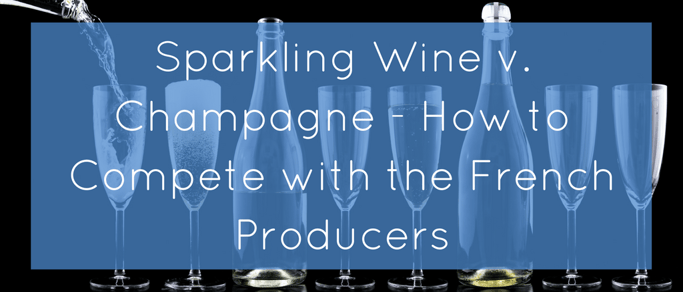The holidays are fast approaching and champagne will soon dominate the shelves where spirits, beer and wine are sold.
But really, is champagne better than sparkling wine? Have consumers been effectively conditioned to believe that champagne is the better fermented drink?
Is there hope for sparkling wine marketing strategies that could displace champagne out of its traditional status symbol ranking?
The Real Difference
The major difference between champagne and sparkling wine is: location, location, location.
Real champagne is actually real sparkling wine. It just originates from Champagne, France and is typically produced with Chardonnay, Pinot Noir or Pinot Meunier grapes. Pinot Blanc, Pinot Gris, Petit Meslier and Arbane are used to lesser degrees.
In addition to geography and grape selection, there is the champagne production process. Champagne is a two-step process of fermentation. It ferments in the bottle. This traps the gases inside which create the trademark "pop" when opened. Sounds crazy but that is the truth.
So how do vintners get the message across to consumers that their sparkling wine is the real deal when it comes to champagne?
Marketing A Message
Grape Identity: First, identify the grapes used to produce your sparkling wine as the very same grapes used to produce champagne.
By connecting your grapes with those preferred by France's champagne producers, you have taken the first step at effective competition.
Tell The Story: Educate the consumer on how France has cornered the legal market on the use of the label "Champagne".
When the Treaty of Versailles was signed, included in a clause was France's ownership of the classification of "Champagne" for sparkling wine. The nation wanted to be certain to protect their dominance in a market that was a crucial part of their country's economy. This prevented German vintners from edging them out of the sparkling wine market with their own version called "Sekt".
The tradition continues with champagne's doppleganger being produced by every winemaking country yet packaged with a variety of labels such as: Sekt, Prosecco, and Cava. Yet virtually all of them can bear the same moniker, sparkling wine.

What's In The Price
Although many party planners may be economizing, thus interested in affordability rather than the status of a label, there will always be the die-hard Champagne loyalist.
It may be that such loyalists are only uninformed as to the virtual non-existence of differences between champagne and sparkling wines. They may be solely basing their opinion of one being better than the other on price tag. There are consumers who maintain the perspective that "you get what you pay for". Such people are convinced that paying more automatically translates into getting a better product. To capture their attention and titillate them into giving your brand a chance, you must educate them on what is behind a price tag. Once they realize that a higher price tag may have nothing at all to do with quality, they may give a locally produced, lower priced sparkling wine a try and become a convert.
So, what does that lower price tag deliver through a locally produced sparkling wine:
- Same quality grapes as in champagne
- Same production method as champagne
- No import cost as with champagne which means, "Voila! Lower price!"
- Lower shipping costs to stock a retailer's shelf which means, "Voila! Lower price!"
Performance & Trends
Although champagne sales are predominantly seasonal, performing strong during the holidays, sparkling wine sales trend year round. This is probably because of their affordability. Wine connoisseurs can enjoy a bit of bubbly as they dine, relax or socialize whenever they please. However, a special occasion results in a splurge of the "good stuff". But maybe not so large of a splurge as has been the historic habit.
In 2012 sparkling wines outperformed champagne in the U.K. By 2015 this trend was also going strong in the U.S. It seems consumers are sold on sparkling wines.
Last year's holiday season had winemakers all abuzz, wondering if sparkling wine was finally going to unseat the holiday drink of choice, champagne.
Between October of 2015 and January of this year, 223 million bottles of champagne were purchased for UK holiday party fare. That impressive number, however, was actually surpassed by the number of bottles of sparkling wine enjoyed by UK partygoers. For US winemakers, a repeat performance of duplicating a trend across the pond does seem to be where the sparkling wine and champagne market is headed.
Take every advantage of opportunity this holiday season with the right marketing campaign. Contact marketing professionals that specialize in beer and wine promotion strategies and ring out the new year with a record sales season.



